
Diuris drummondii, commonly known as the tall donkey orchid is a species of orchid which is endemic to the south-west of Western Australia. It is the tallest Diuris and is distinguished from the similar Diuris emarginata by its larger, more widely spaced flowers. The flowers are pale yellow with brown markings.

Diuris laxiflora, commonly known as bee orchid, is a species of orchid which is endemic to the southwest of Western Australia. It has two to five narrowly linear leaves and up to six yellow flowers with brown markings. It is a small orchid, common within its range and about half the size of the common donkey orchid, Diuris corymbosa.
Diuris heberlei, commonly called Heberle's donkey orchid, is a species of orchid which is endemic to the south-west of Western Australia. It has three to five linear leaves at its base and up to four bright yellow flowers with a reddish brown border around the labellum callus. It is found along the south coast and is one of the last Diuris to flower in Western Australia.

Diuris oporina, commonly called the autumn donkey orchid or northern white donkeys tails is a species of orchid that is endemic to Queensland. It has a single tapering, linear leaf at its base and up to ten white flowers with mauve to purple markings. It grows in the drier parts of the tablelands in Far North Queensland.

Diuris picta, commonly called the granite bee orchid or granite donkey orchid, is a species of orchid which is endemic to the south-west of Western Australia. It has between three and five leaves at its base and up to eight creamy-white to yellow flowers with brownish purple markings. It grows on granite outcrops between Menzies and Lake King.
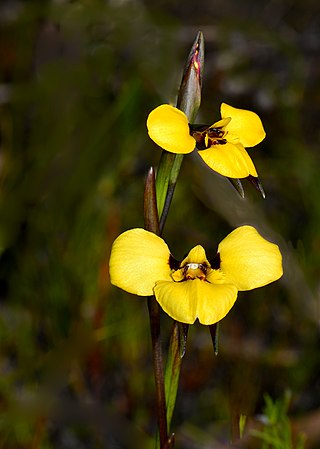
Diuris purdiei, commonly known as Purdie's donkey orchid, is a species of orchid that is endemic to the south-west of Western Australia. It has between five and ten leaves at its base and up to eight pale yellow flowers with reddish-brown or purplish markings. It mainly grows in swampy areas and only flowers after fires the previous summer.
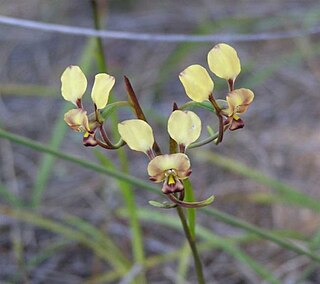
Diuris recurva, commonly called the mini donkey orchid is a species of orchid that is endemic to the south-west of Western Australia. It has one or two leaves at its base, up to six small pale yellow and brownish flowers and grows in winter-wet places between Badgingarra and Kalbarri.
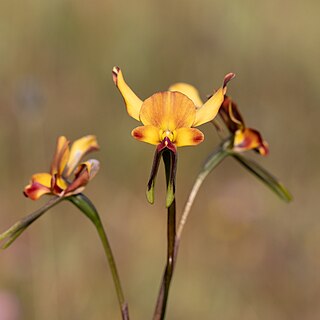
Diuris brachyscapa, commonly known as western wheatbelt donkey orchid, is a species of orchid that is endemic to the south-west of Western Australia. It has two or three linear leaves and a flowering stem with up to four pale yellow flowers with brown markings.
Diuris brevis, commonly known as short-nosed donkey orchid, is a species of orchid that is endemic to a restricted area in the south-west of Western Australia. It has two or three linear leaves and a flowering stem with up to four small yellow and brown flowers with a short labellum.

Diuris brockmanii, commonly known as south coast donkey orchid, is a species of orchid that is endemic to the south-west of Western Australia. It has two or three linear leaves and a flowering stem with up to ten yellow flowers with reddish-brown markings.
Diuris cruenta, commonly known as Kemerton donkey orchid, is a species of orchid that is endemic to the south-west of Western Australia. It has two or three linear leaves and a flowering stem with up to seven pale yellow and reddish-brown flowers, and is similar to D. tinctoria.

Diuris hazeliae, commonly known as yellow granite donkey orchid, is a species of orchid that is endemic to the south-west of Western Australia. It has between two and four linear leaves and up to six bright yellow and reddish-brown flowers.

Diuris leopardina is a species of orchid that is endemic to south-eastern continental Australia. It has between two or three grass-like leaves of different lengths, and a flowering stem with up to five pale yellow to butter yellow flowers with reddish brown or purple marks and patterns, and leopard-like spots on the back.
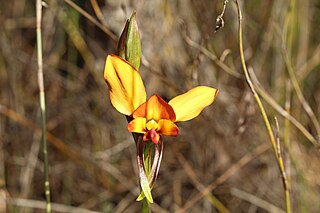
Diuris littoralis, commonly known as Green Range donkey orchid, is a species of orchid that is endemic to the south-west of Western Australia. It has two or three linear leaves and up to six yellow, brown and mauve flowers from late July to early September.

Diuris oraria, commonly known as northern coastal donkey orchid, is a species of orchid that is endemic to a small area of the north coast of Western Australia. It has two or three linear to lance-shaped leaves and up to four yellow flowers with reddish-brown and purple markings.

Diuris ostrina, commonly known as Darling Scarp donkey orchid, is a species of orchid that is endemic to the south-west of Western Australia. It has two or three linear to lance-shaped leaves and up to five brown to brownish-yellow and purple-mauve flowers.
Diuris pallescens, commonly known as pale donkey orchid, is a species of orchid that is endemic to the south-west of Western Australia. It has two or three linear to lance-shaped leaves and up to seven pale yellow flowers with light brown to reddish-brown markings.
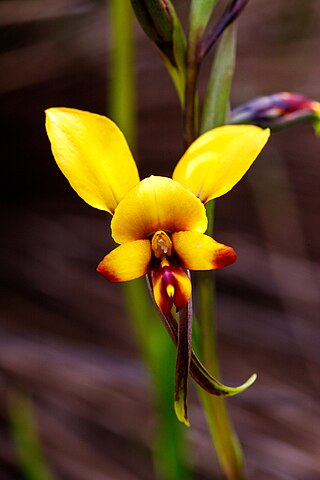
Diuris perialla, commonly known as early donkey orchid, is a species of orchid that is endemic to the south-west of Western Australia. It has two or three linear to lance-shaped leaves and up to four yellow flowers with reddish markings.

Diuris porphyrochila, commonly known as Yalgorup donkey orchid, is a species of orchid that is endemic to the south-west of Western Australia. It has two or three linear to lance-shaped leaves and a flowering stem with up to eight yellow flowers with brown to reddish-brown and purple markings.
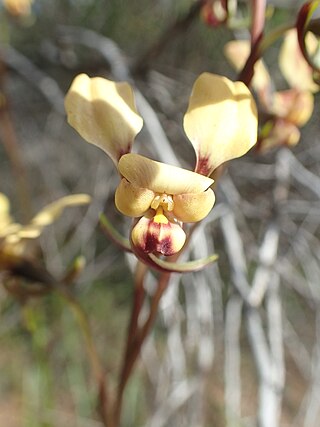
Diuris refracta, commonly known as dainty donkey orchid, is a species of orchid that is endemic to the south-west of Western Australia. It has two or three linear to lance-shaped leaves and up to six yellow flowers with reddish markings.
















